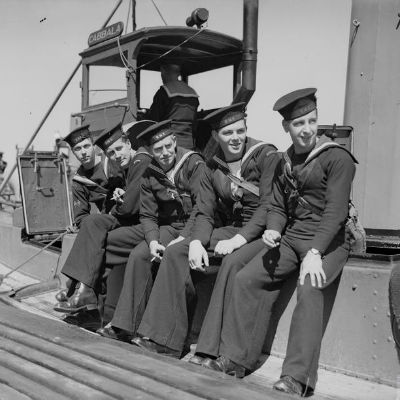Dawn, September 1939. German forces invaded Poland and hostilities began.
‘The Prime Minister asked me to visit him at Downing Street.’ Winston Churchill wrote in his memoirs. ‘I was invited to become a member of the War Cabinet.’ Two days later, 24 years after resigning as First Sea Lord, Winston Churchill returned to the Admiralty.
On September 4, 1939, aged 64, Churchill settled into his former office in Admiralty House. There he found the same sea maps, showing the disposition of ships, he had left in 1915. The Board of the Admiralty sent out a signal to the entire Fleet, ‘Winston is back.’
His first challenge was to rebuild Britain’s naval strength in ships and manpower. The Admiralty began a requisition and building programme to deliver 141 warships from Aircraft Carriers to minesweepers. To support these ships, the Royal Navy made its demand for manpower, 145,000 men, and 13,000 women by the end of 1941. An average intake of 10,000 personnel each month.
With war now imminent, the Government introduced the National Service Bill, which received Royal assent on 3rd September, five hours after the Prime Minister’s declaration of war. The Act superseded the 1939 Military Training Act. Now male subjects, between the ages of 18 and 41 years, were liable to be called up for armed service.
Ministry of Labour and National Service Clerks recorded the personal details of those volunteering, including age, address, occupation and employer. The Act entitled civilians to express an interest in serving in the Royal Navy or Royal Air Force, rather than the Army, or provisionally register as a conscientious objector. Once registered, all were issued with a Certificate of Registration Card (N.S.2.)
The information held on the N.S.2. was then sent to an Allocation Local Office for processing.
Men meeting the age criteria laid out in the Schedule of Reserved Occupations (HMSO 1939) (PDF) and those whose employer had gained approval for their postponement of service were “reserved in their present occupation” and remained in civilian life.
Men provisionally registered as conscientious objectors also remained in civilian life subject to them making an application to their local tribunal for a hearing within 14 days. The remainder, deemed available for military service, remained in civilian life awaiting their invite to medical examination (N.S. 6.)
Medical Boards were attached to each Allocation Local Office. Men were assessed and graded in accordance with fitness. Those in grades I, II and III were deemed suitable for the armed services, those in Grade IV were deemed unsuitable. Psychological testing was introduced in 1941. Mental instability could be a serious problem on a crowded ship in combat and WRENS drafted mostly from a civilian teaching or social work background proved ideal observers of recruits mental health. Both medical and mental health was recorded on a Grade Card (N.S. 55)
Enlistment Notices (N.S. 12) were issued to Grades I-III notifying how to present themselves for service.
By 1941, nearly 400,000 men applied to join the Royal Navy. Of these, 40,812 were Hostilities Only. The term was first used in The Great War to describe merchant seamen, already experienced in nautical matters, who joined the Royal or Merchant Navy. Hostilities Only volunteers of 1939 were different. These were inexperienced men and women from all professions who needed to be trained in the basics of seamanship before moving into one of the specialist branches.
One of those 40,000 ratings was Robert Brooks, an eighteen-year-old pulp boy who worked for an art screen manufacturers in Preston. Eighteen was the minimum age to be accepted as an Hostilities Only rating.
One morning in May 1941, a Preston postman delivered a brown envelope marked ON HIS MAJESTY’S SERVICE. A week later, clutching a one-way rail warrant, 18-year-old Robert Brooks made the long journey from Preston, Lancashire to Fareham in Hampshire to begin seamanship training at HMS Collingwood.










'Winston is Back' has 1 comment
3rd September 2022 @ 8:40 am Arie Pach
I visited the Cabinet War Rooms in 2006, and seeing the place from which Churchill ran WWII brought me to actual tears. I am a Canadian/Israeli citizen, and understand the signal Winston is Back and the effect it had on the British navy, nation, and the world. Even though Churchill was behind the splitting of the Palestine Mandate in 1922, giving 75% to Jordan and reducing future Israel to 20500 square km, I admire him greatly and think he was Britain’s greatest PM ever. In the 1950’s he was an admirer of Israel . So, I see him as a relentless fighter against Nazism, who saved Britain and the world, and my people.